 The
office. Surprisingly uncluttered considering the size. Note
the left hand, straight-shot, gear lever. "Straight-shot"
inasmuch as it shot down the car's centerline (and through anything in
its path), reducing the linkage complexity and length (and weight).
The
office. Surprisingly uncluttered considering the size. Note
the left hand, straight-shot, gear lever. "Straight-shot"
inasmuch as it shot down the car's centerline (and through anything in
its path), reducing the linkage complexity and length (and weight).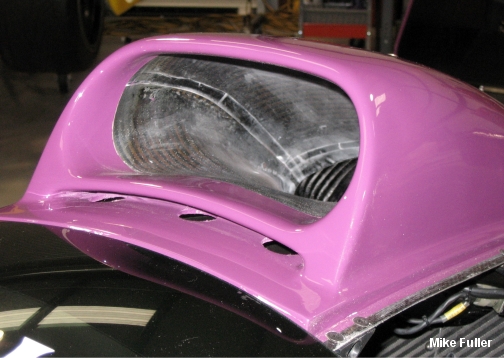 The
XJR-14's engine intake was just above the cockpit. Note the
slit inlet just below the main engine intake. This
siphoned off any thickening boundary layer, but more importantly helped
bleed additional cooling air into the cockpit through the three inlet holes.
The
XJR-14's engine intake was just above the cockpit. Note the
slit inlet just below the main engine intake. This
siphoned off any thickening boundary layer, but more importantly helped
bleed additional cooling air into the cockpit through the three inlet holes. At the XJR-14's debut at Miami, IMSA made TWR alter the design of the engine inlets. IMSA cited their chassis regulation which stated the highest point of the car could not be the engine intake. As such, the TWR crew created a field modification that made the car legal. “This was one of the areas that we thought that NPTI had a hand in!” says Tony Dowe, TWR Team Manager, in referring to arch-rival Nissan and potential gamesmanship. “We had shown Raffauf the car and it had been given an ok. Then when we arrived at
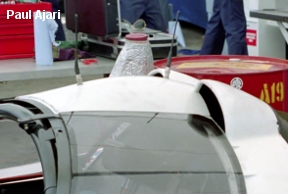 installing two
“Mickey Mouse ear” inlets in place of the original single engine
intake. These would
become permanent
throughout the rest of the IMSA season. Dowe
continues, “The revised inlet helped the mid range power and the rear
wing! So
we were not too unhappy about the change other than the way in which it
was
forced on us.” The guys at TWR Valparaiso created a legality blister
to
the peak of the roof making it the high point and the Mickey Mouse
engine intakes were placed either side and to the height of, though not
above, the blister.
installing two
“Mickey Mouse ear” inlets in place of the original single engine
intake. These would
become permanent
throughout the rest of the IMSA season. Dowe
continues, “The revised inlet helped the mid range power and the rear
wing! So
we were not too unhappy about the change other than the way in which it
was
forced on us.” The guys at TWR Valparaiso created a legality blister
to
the peak of the roof making it the high point and the Mickey Mouse
engine intakes were placed either side and to the height of, though not
above, the blister.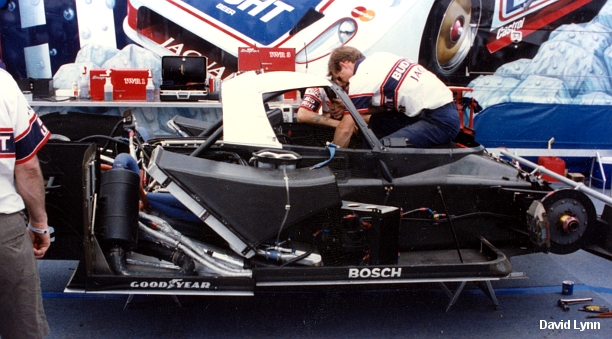 A
period shot of the XJR-14 with most of the bodywork removed. Note
the large muffler just behind the radiator. IMSA regulations
stipulated a 108 db maximum
which necessitated a muffler to reduce dbs from an unimpeded 130+.
The muffler also meant a re-routing of the exhaust exit.
So it moved from exiting just ahead of the rear wheel, out the
side pod, to actually being plumbed into the tunnel section for aero
affect. In the image you can see the exhaust loop rewards
post-muffler and then behind the silencer can. It's there that it
is plumbed into the vertical face of the outer diffuser wall.
A
period shot of the XJR-14 with most of the bodywork removed. Note
the large muffler just behind the radiator. IMSA regulations
stipulated a 108 db maximum
which necessitated a muffler to reduce dbs from an unimpeded 130+.
The muffler also meant a re-routing of the exhaust exit.
So it moved from exiting just ahead of the rear wheel, out the
side pod, to actually being plumbed into the tunnel section for aero
affect. In the image you can see the exhaust loop rewards
post-muffler and then behind the silencer can. It's there that it
is plumbed into the vertical face of the outer diffuser wall. 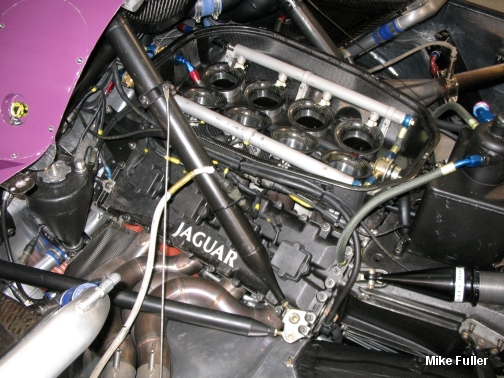 The
main protagonist. The well developed, reliable, light-weight-yet-stout,
and
powerful Jaguar-badged Ford HB gave the XJR-14 an advantage during the early part of the
1991 season inasmuch as it was one less thing to worry about.
The
main protagonist. The well developed, reliable, light-weight-yet-stout,
and
powerful Jaguar-badged Ford HB gave the XJR-14 an advantage during the early part of the
1991 season inasmuch as it was one less thing to worry about. The TWR designed
magnesium
6-speed gearbox had the gear cluster oriented longitudinally and ahead
of the
rear wheel centerline in order to move mass lower and further
forward
in the car as well as making for a simpler yet stiffer gear casing. The starter installation
was unique as well
in that it acted directly on the back of the gearbox input shaft
through a
two-stage epicyclical gearbox and sprag clutch.
This kept its mass low and it was easily accessible
from underneath the
car.
The TWR designed
magnesium
6-speed gearbox had the gear cluster oriented longitudinally and ahead
of the
rear wheel centerline in order to move mass lower and further
forward
in the car as well as making for a simpler yet stiffer gear casing. The starter installation
was unique as well
in that it acted directly on the back of the gearbox input shaft
through a
two-stage epicyclical gearbox and sprag clutch.
This kept its mass low and it was easily accessible
from underneath the
car.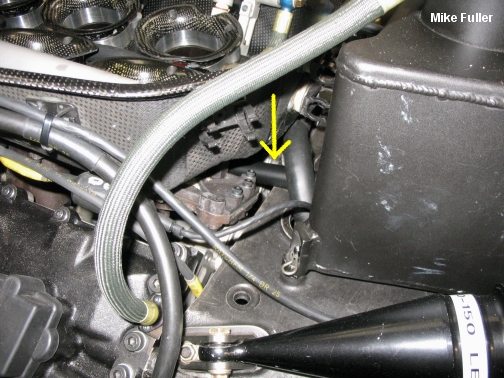 The
gear shift linkage emerges from between the engine inlet trumpets,
having started its travels by going straight through the center of the
fuel cell, to
continue on to the (and through) oil tank reservoir and then to the
gearbox. The gearbox was
also unusual for
its left hand gear change. With
the
driver on the right hand side of the cockpit this allowed for a direct
route
down the center of the car for the shift rod and reduced the number of
joints making for a light and sensitive gear change.
The
gear shift linkage emerges from between the engine inlet trumpets,
having started its travels by going straight through the center of the
fuel cell, to
continue on to the (and through) oil tank reservoir and then to the
gearbox. The gearbox was
also unusual for
its left hand gear change. With
the
driver on the right hand side of the cockpit this allowed for a direct
route
down the center of the car for the shift rod and reduced the number of
joints making for a light and sensitive gear change.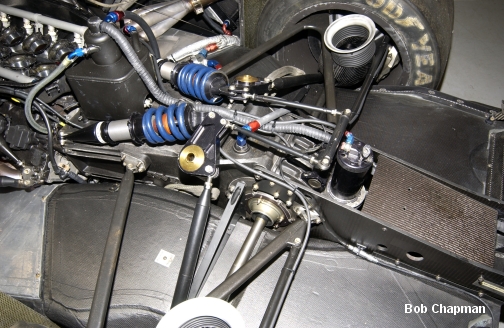 The
rear suspension consisted of conventional spring dampers mounted
to
the bellhousing and operating off of bell cranks attached to pushrods.
The only element of the rear suspension in the underfloor
airflow
was the lower A-arm.
The
rear suspension consisted of conventional spring dampers mounted
to
the bellhousing and operating off of bell cranks attached to pushrods.
The only element of the rear suspension in the underfloor
airflow
was the lower A-arm.
